
Perform test of hypotheses that gender and admission are independent for each department at the level of significance of
Prove that the only department for which this hypothesis is rejected is department A.
Also prove that the admission rate for women in department A is significantly higher than the rate for men.
Answer to Problem 4CS
There is enough evidence to conclude that the gender and admission are not independent of gender in department A.
There is not enough evidence to conclude that the gender and admission are not independent of gender in department B.
There is not enough evidence to conclude that the gender and admission are not independent of gender in department C.
There is not enough evidence to conclude that the gender and admission are not independent of gender in department D.
There is not enough evidence to conclude that the gender and admission are not independent of gender in department E.
There is not enough evidence to conclude that the gender and admission are not independent of gender in department F.
Explanation of Solution
Calculation:
The six contingency tables with 2 rows and 2 columns for each of the six departments are given. The two rows consist of gender and the two columns consist of accepted and rejected applicants.
A contingency table is obtained as using two qualitative variables. One of the qualitative variable is row variable that has one category for each row of the table another is column variable has one category for each column of the table.
Step 1:
For Department A:
The hypotheses are:
Null Hypothesis:
Alternate Hypothesis:
Step 2:
Now, it is obtained that,
| Gender | Accept | Reject | Row Total |
| Male | 512 | 313 | 825 |
| Female | 89 | 19 | 108 |
| Column Total | 601 | 332 | 933 |
Step 3:
Expected frequencies:
The expected frequencies in case of contingency table is obtained as,
Now, using the formula of expected frequency it is found that the expected frequency for the accepted male is obtained as,
Hence, in similar way the expected frequencies are obtained as,
| Gender | Accept | Reject |
| Male | ||
| Female |
The accept and reject can be rewritten as,
| Accept | 1 |
| Reject | 2 |
Step 4:
Level of significance:
The level of significance is given as 0.01.
Test Statistic:
Software procedure:
Step -by-step software procedure to obtain test statistic using MINITAB software is as follows:
- Select Stat > Table > Cross Tabulation and Chi-Square.
- Check the box of Raw data (categorical variables).
- Under For rows enter Gender.
- Under For columns enter Column.
- Check the box of Count under Display.
- Under Chi-Square, click the box of Chi-Square test.
- Select OK.
- Output using MINITAB software is given below:

Thus, the value of chi-square statistic is 17.248.
It is known that under the null hypothesis
In the given question there are 2 rows and 2 columns.
Hence, the degrees of freedom is
Thus, the degrees of freedom is 1.
It is known that when the null hypothesis
It is found that all the expected frequencies corresponding to all rows and columns of the given contingency table are more than 5.
Hence, the test of independence is appropriate.
Step 5:
Critical value:
In a test of hypotheses the critical value is the point by which one can reject or accept the null hypothesis.
Software procedure:
Step-by-step software procedure to obtain critical value using MINITAB software is as follows:
- Select Graph > Probability distribution plot > view probability
- Select Chi -Square under distribution.
- In Degrees of freedom, enter 1.
- Choose Probability Value and Right Tail for the region of the curve to shade.
- Enter the Probability value as 0.01 under shaded area.
- Select OK.
- Output using MINITAB software is given below:
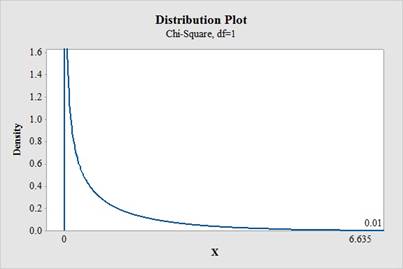
Hence, the critical value at
Rejection rule:
If the
Step 6:
Conclusion:
Here, the
That is,
Thus, the decision is “reject the null hypothesis”.
Thus, there is enough evidence to conclude that the gender and admission are not independent of gender in department A.
For Department B:
Step 1:
The hypotheses are:
The hypotheses are:
Null Hypothesis:
Alternate Hypothesis:
Step 2:
Now, it is obtained that,
| Gender | Accept | Reject | Row Total |
| Male | 353 | 207 | 560 |
| Female | 17 | 8 | 25 |
| Column Total | 370 | 215 | 585 |
Step 3:
Now, using the formula of expected frequency it is found that the expected frequency for the accepted male is obtained as,
Hence, in similar way the expected frequencies are obtained as,
| Gender | Accept | Reject |
| Male | ||
| Female |
The accept and reject can be rewritten as,
| Accept | 1 |
| Reject | 2 |
Step 4:
Level of significance:
The level of significance is given as 0.01.
Test Statistic:
Software procedure:
Step -by-step software procedure to obtain test statistic using MINITAB software is as follows:
- Select Stat > Table > Cross Tabulation and Chi-Square.
- Check the box of Raw data (categorical variables).
- Under For rows enter Gender.
- Under For columns enter Column.
- Check the box of Count under Display.
- Under Chi-Square, click the box of Chi-Square test.
- Select OK.
- Output using MINITAB software is given below:
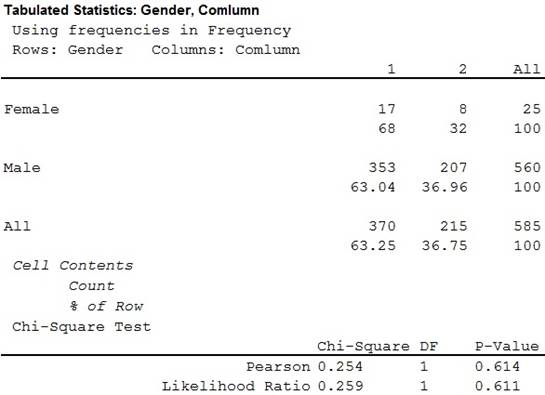
Thus, the value of chi-square statistic is 0.254.
In the given question there are 2 rows and 2 columns.
Hence, the degrees of freedom is
Thus, the degrees of freedom is 1.
It is known that when the null hypothesis
It is found that all the expected frequencies corresponding to all rows and columns of the given contingency table are more than 5.
Hence, the test of independence is appropriate.
Step 5:
Critical value:
In a test of hypotheses the critical value is the point by which one can reject or accept the null hypothesis.
It is already found that the critical value at
Rejection rule:
If the
Step 6:
Conclusion:
Here, the
That is,
Thus, the decision is “fail to reject the null hypothesis”.
Thus, there is not enough evidence to conclude that the gender and admission are not independent of gender in department B.
For Department C:
Step 1:
The hypotheses are:
Null Hypothesis:
Alternate Hypothesis:
Step 2:
Now, it is obtained that,
| Gender | Accept | Reject | Row Total |
| Male | 120 | 205 | 325 |
| Female | 202 | 391 | 593 |
| Column Total | 322 | 596 | 918 |
Step 3:
Now, using the formula of expected frequency it is found that the expected frequency for the accepted male is obtained as,
Hence, in similar way the expected frequencies are obtained as,
| Gender | Accept | Reject |
| Male | ||
| Female |
The accept and reject can be rewritten as,
| Accept | 1 |
| Reject | 2 |
Step 4:
Level of significance:
The level of significance is given as 0.01.
Test Statistic:
Software procedure:
Step -by-step software procedure to obtain test statistic using MINITAB software is as follows:
- Select Stat > Table > Cross Tabulation and Chi-Square.
- Check the box of Raw data (categorical variables).
- Under For rows enter Gender.
- Under For columns enter Column.
- Check the box of Count under Display.
- Under Chi-Square, click the box of Chi-Square test.
- Select OK.
- Output using MINITAB software is given below:
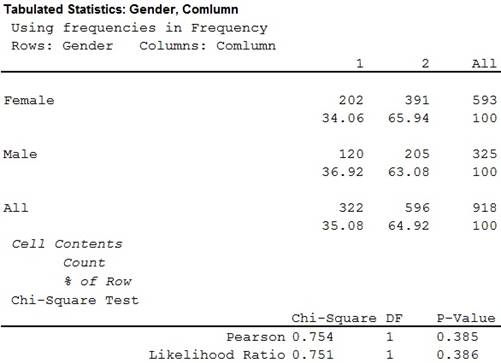
Thus, the value of chi-square statistic is 0.754.
In the given question there are 2 rows and 2 columns.
Hence, the degrees of freedom is
Thus, the degrees of freedom is 1.
It is known that when the null hypothesis
It is found that all the expected frequencies corresponding to all rows and columns of the given contingency table are more than 5.
Hence, the test of independence is appropriate.
Step 5:
Critical value:
In a test of hypotheses the critical value is the point by which one can reject or accept the null hypothesis.
It is already found that the critical value at
Rejection rule:
If the
Step 6:
Conclusion:
Here, the
That is,
Thus, the decision is “fail to reject the null hypothesis”.
Thus, there is not enough evidence to conclude that the gender and admission are not independent of gender in department C.
For Department D:
Step 1:
The hypotheses are:
Null Hypothesis:
Alternate Hypothesis:
Step 2:
Now, it is obtained that,
| Gender | Accept | Reject | Row Total |
| Male | 138 | 279 | 417 |
| Female | 131 | 244 | 375 |
| Column Total | 269 | 523 | 792 |
Step 3:
Now, using the formula of expected frequency it is found that the expected frequency for the accepted male is obtained as,
Hence, in similar way the expected frequencies are obtained as,
| Gender | Accept | Reject |
| Male | ||
| Female |
The accept and reject can be rewritten as,
| Accept | 1 |
| Reject | 2 |
Step 4:
Level of significance:
The level of significance is given as 0.01.
Test Statistic:
Software procedure:
Step -by-step software procedure to obtain test statistic using MINITAB software is as follows:
- Select Stat > Table > Cross Tabulation and Chi-Square.
- Check the box of Raw data (categorical variables).
- Under For rows enter Gender.
- Under For columns enter Column.
- Check the box of Count under Display.
- Under Chi-Square, click the box of Chi-Square test.
- Select OK.
- Output using MINITAB software is given below:
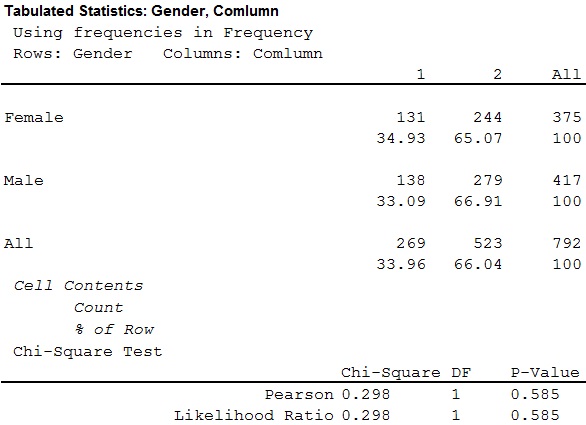
Thus, the value of chi-square statistic is 0.298.
In the given question there are 2 rows and 2 columns.
Hence, the degrees of freedom is
Thus, the degrees of freedom is 1.
It is known that when the null hypothesis
It is found that all the expected frequencies corresponding to all rows and columns of the given contingency table are more than 5.
Hence, the test of independence is appropriate.
Step 5:
Critical value:
In a test of hypotheses the critical value is the point by which one can reject or accept the null hypothesis.
It is already found that the critical value at
Rejection rule:
If the
Step 6:
Conclusion:
Here, the
That is,
Thus, the decision is “fail to reject the null hypothesis”.
Thus, there is not enough evidence to conclude that the gender and admission are not independent of gender in department D.
For Department E:
Step 1:
The hypotheses are:
Null Hypothesis:
Alternate Hypothesis:
Step 2:
Now, it is obtained that,
| Gender | Accept | Reject | Row Total |
| Male | 53 | 138 | 191 |
| Female | 94 | 299 | 383 |
| Column Total | 147 | 437 | 584 |
Step 3:
Now, using the formula of expected frequency it is found that the expected frequency for the accepted male is obtained as,
Hence, in similar way the expected frequencies are obtained as,
| Gender | Accept | Reject |
| Male | ||
| Female |
Step 4:
Level of significance:
The level of significance is given as 0.01.
Test Statistic:
Software procedure:
Step -by-step software procedure to obtain test statistic using MINITAB software is as follows:
- Select Stat > Table > Cross Tabulation and Chi-Square.
- Check the box of Raw data (categorical variables).
- Under For rows enter Gender.
- Under For columns enter Column.
- Check the box of Count under Display.
- Under Chi-Square, click the box of Chi-Square test.
- Select OK.
- Output using MINITAB software is given below:
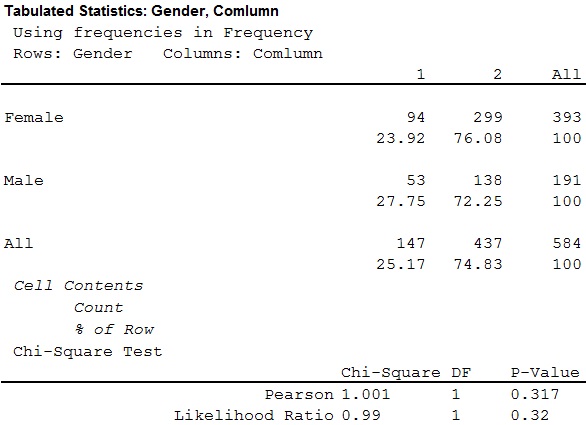
Thus, the value of chi-square statistic is 1.001.
In the given question there are 2 rows and 2 columns.
Hence, the degrees of freedom is
Thus, the degrees of freedom is 1.
It is known that when the null hypothesis
It is found that all the expected frequencies corresponding to all rows and columns of the given contingency table are more than 5.
Hence, the test of independence is appropriate.
Step 5:
Critical value:
In a test of hypotheses the critical value is the point by which one can reject or accept the null hypothesis.
It is already found that the critical value at
Rejection rule:
If the
Step 6:
Conclusion:
Here, the
That is,
Thus, the decision is “fail to reject the null hypothesis”.
Thus, there is not enough evidence to conclude that the gender and admission are not independent of gender in department E.
For Department F:
Step 1:
The hypotheses are:
Null Hypothesis:
Alternate Hypothesis:
Step 2:
Now, it is obtained that,
| Gender | Accept | Reject | Row Total |
| Male | 22 | 351 | 373 |
| Female | 24 | 317 | 341 |
| Column Total | 46 | 668 | 714 |
Step 3:
Now, using the formula of expected frequency it is found that the expected frequency for the accepted male is obtained as,
Hence, in similar way the expected frequencies are obtained as,
| Gender | Accept | Reject |
| Male | ||
| Female |
The accept and reject can be rewritten as,
| Accept | 1 |
| Reject | 2 |
Step 4:
Level of significance:
The level of significance is given as 0.01.
Test Statistic:
Software procedure:
Step -by-step software procedure to obtain test statistic using MINITAB software is as follows:
- Select Stat > Table > Cross Tabulation and Chi-Square.
- Check the box of Raw data (categorical variables).
- Under For rows enter Gender.
- Under For columns enter Column.
- Check the box of Count under Display.
- Under Chi-Square, click the box of Chi-Square test.
- Select OK.
- Output using MINITAB software is given below:
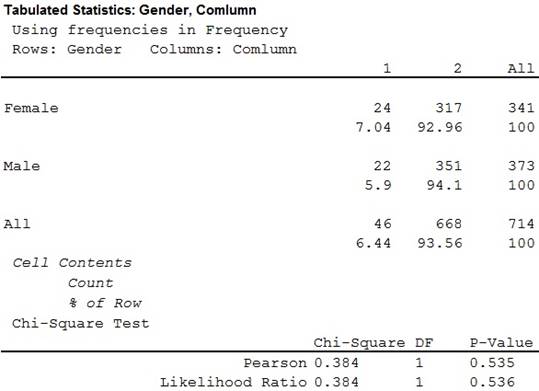
Thus, the value of chi-square statistic is 0.384.
In the given question there are 2 rows and 2 columns.
Hence, the degrees of freedom is
Thus, the degrees of freedom is 1.
It is known that when the null hypothesis
It is found that all the expected frequencies corresponding to all rows and columns of the given contingency table are more than 5.
Hence, the test of independence is appropriate.
Step 5:
Critical value:
In a test of hypotheses the critical value is the point by which one can reject or accept the null hypothesis.
It is already found that the critical value at
Rejection rule:
If the
Step 6:
Conclusion:
Here, the
That is,
Thus, the decision is “fail to reject the null hypothesis”.
Thus, there is not enough evidence to conclude that the gender and admission are not independent of gender in department F.
Thus, it is clear that the only department for which this hypothesis is rejected is department A.
The accepted number of women out of total 108 women is 89.
Hence, the percentage of accepted number of women in department A is,
The accepted number of men out of total 825 men is 512.
Hence, the accepted number of men in department A is,
Thus, it can be concluded that the admission rate for women in department A is significantly higher than the rate for men.
Want to see more full solutions like this?
Chapter 10 Solutions
Essential Statistics
 MATLAB: An Introduction with ApplicationsStatisticsISBN:9781119256830Author:Amos GilatPublisher:John Wiley & Sons Inc
MATLAB: An Introduction with ApplicationsStatisticsISBN:9781119256830Author:Amos GilatPublisher:John Wiley & Sons Inc Probability and Statistics for Engineering and th...StatisticsISBN:9781305251809Author:Jay L. DevorePublisher:Cengage Learning
Probability and Statistics for Engineering and th...StatisticsISBN:9781305251809Author:Jay L. DevorePublisher:Cengage Learning Statistics for The Behavioral Sciences (MindTap C...StatisticsISBN:9781305504912Author:Frederick J Gravetter, Larry B. WallnauPublisher:Cengage Learning
Statistics for The Behavioral Sciences (MindTap C...StatisticsISBN:9781305504912Author:Frederick J Gravetter, Larry B. WallnauPublisher:Cengage Learning Elementary Statistics: Picturing the World (7th E...StatisticsISBN:9780134683416Author:Ron Larson, Betsy FarberPublisher:PEARSON
Elementary Statistics: Picturing the World (7th E...StatisticsISBN:9780134683416Author:Ron Larson, Betsy FarberPublisher:PEARSON The Basic Practice of StatisticsStatisticsISBN:9781319042578Author:David S. Moore, William I. Notz, Michael A. FlignerPublisher:W. H. Freeman
The Basic Practice of StatisticsStatisticsISBN:9781319042578Author:David S. Moore, William I. Notz, Michael A. FlignerPublisher:W. H. Freeman Introduction to the Practice of StatisticsStatisticsISBN:9781319013387Author:David S. Moore, George P. McCabe, Bruce A. CraigPublisher:W. H. Freeman
Introduction to the Practice of StatisticsStatisticsISBN:9781319013387Author:David S. Moore, George P. McCabe, Bruce A. CraigPublisher:W. H. Freeman





